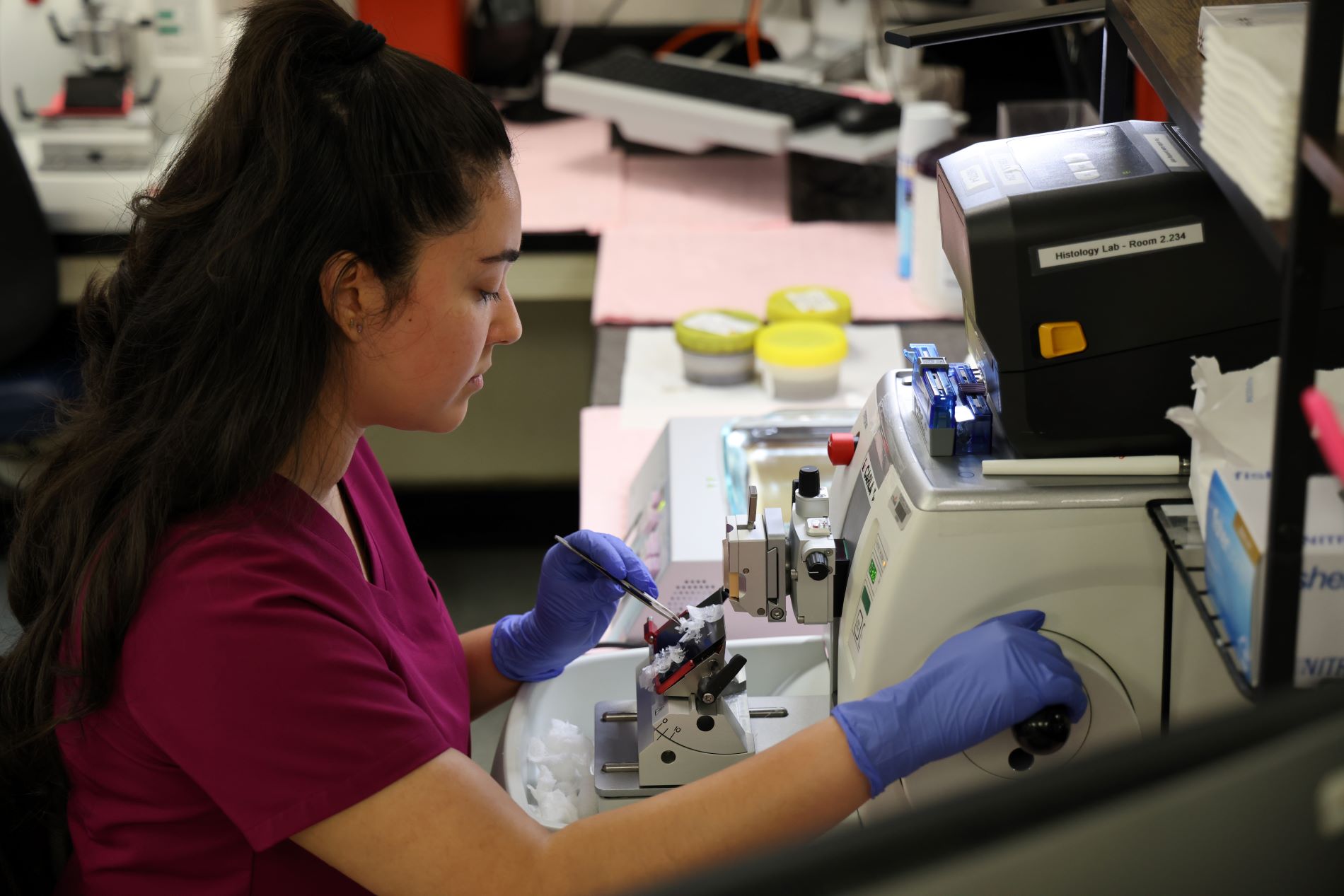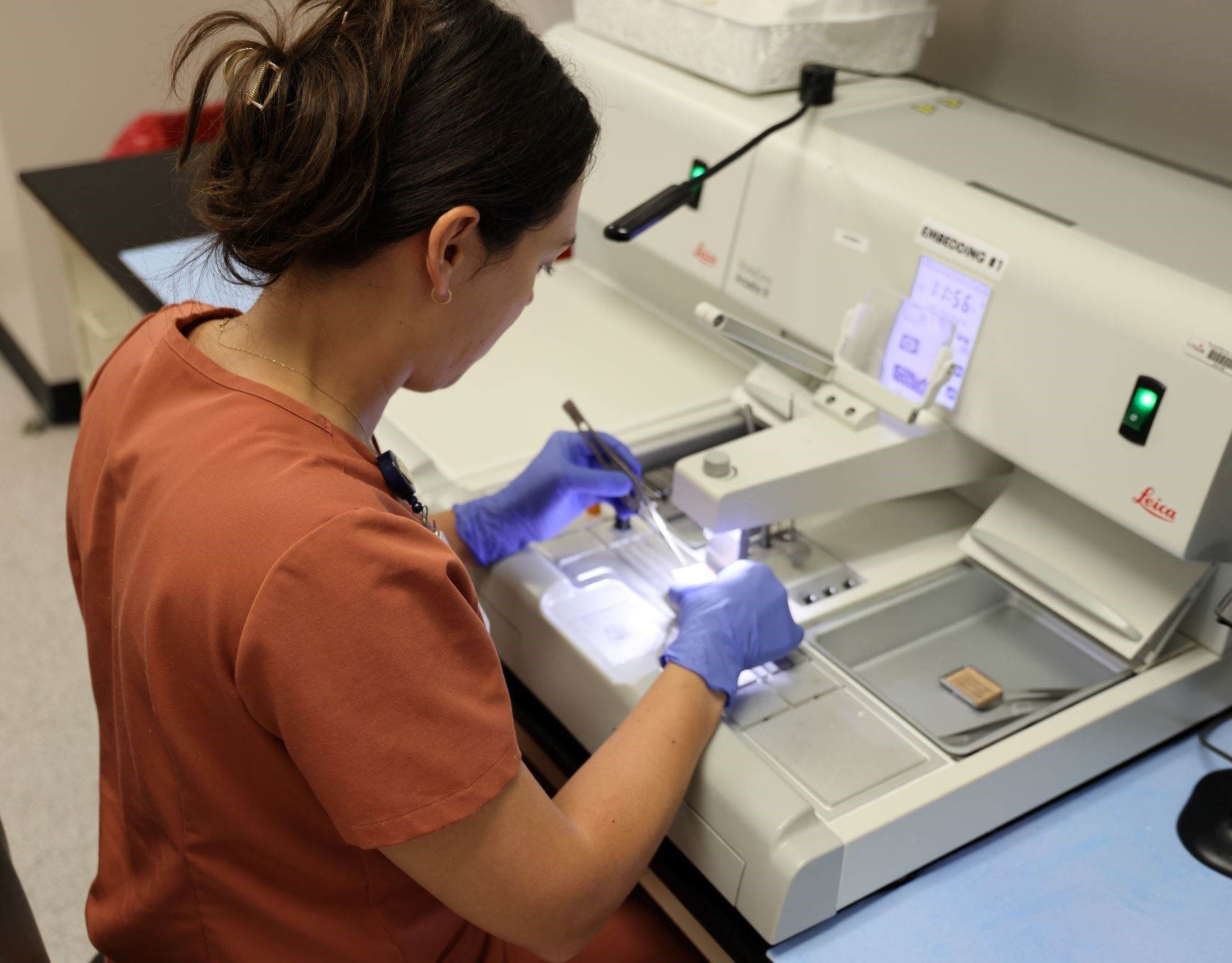Histology Laboratory
 Comprehensive Histology Services
Comprehensive Histology Services
The UTPath Histology Laboratory offers expert histology services to support healthcare providers across Texas. We handle all aspects of specimen processing, including grossing, paraffin embedding, microtomy, and staining for routine biopsies and surgical resections.
Services Offered:
- Routine Histology: We specialize in processing routine biopsies and surgical resections, offering comprehensive services that include:
- Grossing
- Processing
- Paraffin Embedding
- Microtomy
- Histologic Staining
- Immunohistochemical Staining: We provide a broad array of immunohistochemical (IHC) staining services, including uncommon markers.
- Special Stains: We offer a variety of special stains to meet the specific needs of each case.
- Specialized Tissue Processing: For kidney, heart, nerve, and muscle biopsies, visit our Special Tissues Laboratory.

At UTPath, we are committed to providing healthcare providers with dependable histology services to ensure the best patient care. We strive to meet your needs with precision and efficiency. Trust us to support your diagnostic efforts every step of the way.
Contact us:
- For supplies or processing information: 713-500-5255 or [email protected]
- For questions regarding Billing for Technical or Professional Component Only: 713-500-5401.
Laboratory Manager: Melissa Stephens, MS HTL(ASCP)
| Currently available IHC Stains | Sort | Sort |
|---|---|---|
| ACTH | Actin (MSA/Muscle Specific Actin) | Adenovirus |
| Adhalin | AE1/AE3 (CK AE1/AE3, Pankeratin) | ALK-1 Protein (CD246) |
| ALK-1 D5F3 | Alpha Fetoprotein (AFP) | Alpha-1-Antitrypsin |
| Alpha-Synuclein | Amyloid A | Androgen Receptor |
| Arginase-1 | ATRX | B72.3 (TAG-72) |
| BAX | Beta Amyloid | Beta Catenin |
| Beta Dystroglycan | BCL-2 | BCL-6 |
| BCL-10 | BerEP4 | Brachyury |
| BRAF (V600E) | BRG (SMARCA4) | C3d |
| C4d | C5b9 | CA-125 (MUC 16) |
| Calcitonin | Calretinin | Carbonic Anhydrase (CAIX) |
| CAM 5.2 (CK8) | Caveolin-1 | Caveolin-3 |
| CD1a | CD2 | CD3 |
| CD4 | CD5 | CD7 |
| CD8 | CD10 | CD15 (Leu-M1) |
| CD20 | CD21 | CD23 (FC Epsilon RII) |
| CD30 | CD31 | CD34 |
| CD38 | CD43 (Leukosialin/Ly48) | CD44 |
| CD45 (LCA) | CD56 (NCAM) | CD57 (Leu7) |
| CD61 (Platelet Glycoprotein IIIa) | CD68 | CD79a (MB-1) |
| CD99 (MIC2/Ewing’s Sarcoma) | CD117 (c-kit) | CD138 (Syndecan-1/SDC1) |
| CDX-2 | CEA (mono) | CEA (poly) |
| Chromogranin A | CK Pan (Pan-cytokeratin) | CKHMW (34BE12) |
| CK5/6 | CK7 (K7/SCL) | CK14 |
| CK19 (K19) | CK20 | Claudin 4 |
| Claudin 18 | Collagen III | Collagen IV |
| Collagen VI | COVID19 (Research Only) | COX-2 |
| C-Reactive Protein (CRP) | C-term | Cyclin D1 (Bcl-1) |
| Cytomegalovirus (CMV) | D2-40 | Desmin |
| DOG-1 | Dysferlin | Dystrophin (N-terminus) |
| E-Cadherin | EGFR | Emerin |
| Epithelial Membrane Antigen (EMA) | Epstein Barr Virus (EBV-LMP) | ERG |
| Estrogen Receptor Alpha | Estrogen Receptor EP1 (88360) | FABP |
| Factor 8 Related Antigen | Factor 13a | Fast Myosin |
| FSH | Gamma Sarcoglycan | Gastrin |
| GATA 3 | GCDFP (BRST-2) | GH |
| Glial Fibrillary Acidic Protein (GFAP) | Glucagon | GLUT-1 |
| Glutamine Synthetase | Glypican 3 (GPC3) | H3K27M |
| Helicobacter pylori | HBME-1 | HCG |
| HepPar1 (Hepatocyte Specific Antigen) | Hepatitis B Core Antigen | Hepatitis B Surface Antigen |
| Herpes Simplex Virus I&II (HSV) | HHV-8 | HSP70 |
| Human Melanoma (HMB45) | Human Papilloma Virus (HPV) | IDH1 p.R132H |
| IgG | IgG4 | IMP3 |
| Inhibin | INI1 (BAF47) | Insulin |
| INSM1 | Kappa | Ki67 |
| Ki67 (88360) | Lambda | LH |
| Mart-1 (Melan A) | Maspin | Mast Cell Tryptase |
| Merosin | MHC-Type1 | Mid-Rod Dystrophin |
| MITF | MOC31 | MSI Panel (MLH1/MSH2/ MSH6/PMS2) |
| MUC1 | MUC2 | MUC4 |
| MUC5AC | MUC6 | MUM-1 (IRF4) |
| Myeloperoxidase (MPO) | Myogenin | Myoglobin |
| Myosin Heavy Chain (SMMS-1) | Napsin A | Nestin |
| Neu-N | Neurofilament (NF) | NKX3.1 |
| NSE | N-Cadherin | NUT (C52B1) |
| OCT 3/4 | p16 | p27 (kip-1) |
| p40 | p53 BP-53-12-1 (BioGenix) | p53 DO7 |
| p63 | p504s (Racemase/AMARC) | Pan Trk |
| Parvovirus | PAX-5 (BSAP) | PAX-8 |
| PHH3 | PIN Cocktail (p63 & p504s double stain) | PgR/Progesterone Receptor |
| PgR 1294 (88360) | Placental Alkaline Phosphatase (PLAP) | Prolactin |
| Prostate Specific Antigen (PSA) | Prostatic Acid Phosphatase (PAP) | PTH (Parathyroid Hormone) |
| Renal Cell Carcinoma (RCC) | ROS1 | S100 Protein |
| S100P (S100 calcium-binding Protein P) | SALL4 | SDHB |
| SF-1 | SMA Alpha (Smooth Muscle Actin) | Sox10 |
| Spectrin | Spirochete (T. pallidum) | STAT6 |
| SV-40 T Antigen | Synaptophysin | Tau |
| Tdt (DNTT) | Thyroglobulin | Thymidylate Synthase (TS) |
| Topoisomerase II alpha (Topo IIa) | Toxoplasma | TSH |
| TTF-1 | Ubiquitin | Varicella |
| VEGF | Villin | Vimentin |
| Wilms Tumor (WT1) | YAP1 |
| Currently available Special Stains | Sort | Sort |
|---|---|---|
| Acid Fast Bacteria (AFB) | AFB, Fite | Alcian Blue pH 2.5 |
| Congo Red (Amyloid) | Copper | Diff-Quik |
| Elastic | GMS Fungus | GMS-Diastase |
| Gram Stain | Hall’s Bilirubin (Bile) | Iron |
| Iron, Colloidal | Luxol Fast Blue | Mucicarmine |
| PAS | PAS-Diastase | Reticulin |
| Trichrome | Von Kossa (Calcium) | Warthin-Starry |
| Jones Silver | Oil Red O | NADH |
| Trichrome Gomori | Myophosphorylase | Cytochrome C |
| NSE | ATPase 4.3 | ATPase 4.6 |
| ATPase 9.4 | Acid Phosphatase | SDH |
PharmDx Kits (FDA Approved):
-
- Hercept Test (HER2 IHC)
- PD-L1 22C3
- Her-2-neu (FISH)
Chromogenic In-Situ Hybridization:
-
- EVER-1 (Epstein Barr Virus/EBV)
- HPV ISH (HR Cocktail+HPV16/18)
- Kappa ISH
- Lambda ISH
Specimen Submission Requirements:
-
- Following collection, specimens should be immediately placed in 10% neutral buffered formalin in an appropriately sized container with a formalin to specimen ratio of 10:1.
- Each separately identified specimen should be given its own container and labeled with patient identifiers, along with date, time, and site of collection.
- Only one requisition is necessary per patient, but should list each individual specimen collected and the collection site. This information should match what is recorded on each specimen container.